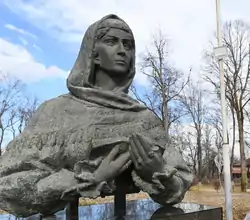Bust of Khurshidbanu Natavan
The Bust of Khurshidbanu Natavan (Azerbaijani: Xurşidbanu Natəvanın büstü), also known as the Monument of Natavan, Daughter of the Khan (Azerbaijani: Xan qızı Natəvanın abidəsi), is a public bronze bust of Khurshidbanu Natavan displayed in Shusha, Azerbaijan. The bust, made by the Azerbaijani sculptress Hayat Abdullayeva and unveiled in 1982, was heavily damaged by the Armenian forces when they captured Shusha in 1992, during the First Nagorno-Karabakh War, and was transferred to Armenia. It was then bought by the Azerbaijani authorities in Georgia, and transferred to Azerbaijan, to be displayed in the yard of the Azerbaijani National Museum of Art in Baku. In 2020, the Azerbaijani forces recaptured Shusha, and the bust was returned to the city in January 2021.
| Bust of Khurshidbanu Natavan | |
|---|---|
| Azerbaijani: Xurşidbanu Natəvanın büstü | |
 The bust in January 2021 | |
| Artist | Hayat Abdullayeva |
| Year | 1982 |
| Type | Sculpture |
| Medium | Bronze |
| Subject | Khurshidbanu Natavan |
| Location | Shusha |
| Owner | Shusha City Executive Power |
History
The bronze bust[1] was made by the Azerbaijani sculptress Hayat Abdullayeva, and was unveiled in 1982, in Shusha, Azerbaijani SSR, which was then part of the Soviet Union. It depicts Khurshidbanu Natavan, a 19th-century Azerbaijani poet.[2]
On 8 May 1992, during the First Nagorno-Karabakh War,[3] the Armenian forces captured Shusha, and its Azerbaijani population of about 15,000 people,[4] was forced to flee.[5] Most of the city came into ruins,[6] with the city turning into a ghost town.[4] The Armenian forces heavily damaged the bust, with bullets marks being visible throughout the sculpture. It was transferred to Armenia, and then were purchased by the Azerbaijani authorities in Tbilisi, Georgia.[1][7] The bust was transferred to Baku, the capital of Azerbaijan, and was kept in the courtyard of the headquarters of the Red Cross[8] until being moved to the yard of the Azerbaijani National Museum of Art in Baku.[9]
The British journalist Thomas de Waal, who saw the monuments in Baku, wrote:
After capturing the city, the Armenians in revenge dismantled and sold bronze busts of three Azerbaijani musicians and poets, natives of Shusha, and these relics were miraculously saved, this time thanks to a scrap metal buyer in Tbilisi. I saw these three bronze busts–in a deplorable state, with traces of bullets, they were lying in the courtyard of the headquarters of the Red Cross in Baku. The poetess Natevan with a head covered with a scarf, holding a book in her hand with a broken thumb; the composer Hajibeyov, speckled with bullets, in a double-breasted jacket and broken glasses, and the famous singer Bulbul, who looks like a thinker ... with a bulging bronze forehead."[8]
Azerbaijan recaptured Shusha after a three-day long battle on 8 November 2020, during the Second Nagorno-Karabakh War.[10][11][12] On 15 January, the President of Azerbaijan, Ilham Aliyev, and the First-Vice President Mehriban Aliyeva visited Shusha,[13] and the bust was returned to the city the next day.[14]
References
- de Waal 2003, p. 190.
- "ABDULLAYEVA Həyat Həmdulla qızı". Azerbaijani National Encyclopedia (in Azerbaijani). 1. Azerbaijani National Academy of Sciences. ISBN 978-9952-441-02-4. Archived from the original on 18 February 2019.
- Durch 1996, p. 444.
- "Шуша - цитадель Карабаха: почему она важна для азербайджанцев и армян" [Shusha is the citadel of Karabakh: why is it important for Azerbaijanis and Armenians]. BBC Russian Service (in Russian). 7 November 2020. Archived from the original on 9 November 2020. Retrieved 28 January 2021.
- Goble 2020, p. 2.
- de Waal, Thomas (10 May 2002). "Shusha Armenians Recall Their Bittersweet Victory". Institute for War and Peace Reporting. Archived from the original on 5 October 2015. Retrieved 28 January 2021.
- Mehdiyev, Mushvig (17 January 2021). "President Aliyev Visits Shusha, Breaks Ground for New Airport in Karabakh Region". Caspian News. Archived from the original on 17 January 2021. Retrieved 17 January 2021.
- "Глава 12. Шуша. Последняя цитадель" [Chapter 12. Shusha. The last citadel]. BBC Russian Service (in Russian). 12 July 2005. Archived from the original on 22 December 2019. Retrieved 1 February 2021.
- "Natavan bust then and today". Karabakh. Archived from the original on 8 October 2007. Retrieved 1 February 2021.
- "Key Town In Nagorno-Karabakh Falls As Azerbaijan Presses Forward in Breakaway Region". RFE/RL. 9 November 2020. Archived from the original on 29 November 2020. Retrieved 29 November 2020.
- "Ethnic Armenian forces confirm loss of Karabakh's second city, say enemy nearing capital". Reuters. 9 November 2020. Archived from the original on 29 November 2020. Retrieved 29 November 2020.
- "Ethnic Armenians confirm loss of Shusha to Azeri forces". Al Jazeera. 9 November 2020. Retrieved 28 November 2020.
- "Azerbaijani president, first lady visit building of executive power, house-museum of Bulbul in Shusha". Trend News Agency. 15 January 2021. Archived from the original on 15 January 2021. Retrieved 17 January 2021.
- "Rusiya Təhlükəsizlik Şurasında Qarabağ üzrə danışıqlar müzakirə edilib, Prezident İlham Əliyev və Mehriban Əliyeva Şuşada tarixi yerləri gəziblər" [The talks on Karabakh were discussed at the Russian Security Council, and President Ilham Aliyev and Mehriban Aliyeva visited historical sites in Shusha]. BBC Azerbaijani Service (in Azerbaijani). 15 January 2021. Archived from the original on 17 January 2021. Retrieved 15 January 2021.
Sources
- Durch, William J. (1996). UN Peacekeeping, American Politics, and the Uncivil Wars of the 1990s. New York: Palgrave Macmillan. ISBN 0-312-12930-0.
- Goble, Paul (12 November 2020). "Shusha Once Again Key to War and Peace Between Armenia and Azerbaijan". Eurasia Daily Monitor. Jamestown Foundation. 17 (160). Archived from the original on 1 January 2021. Retrieved 1 January 2021.
- de Waal, Thomas (2003). Black Garden: Armenia and Azerbaijan through Peace and War. New-York: New-York University Press. ISBN 0-8147-1945-7.
External links
![]() Media related to Bust of Khurshidbanu Natavan, Shusha at Wikimedia Commons
Media related to Bust of Khurshidbanu Natavan, Shusha at Wikimedia Commons